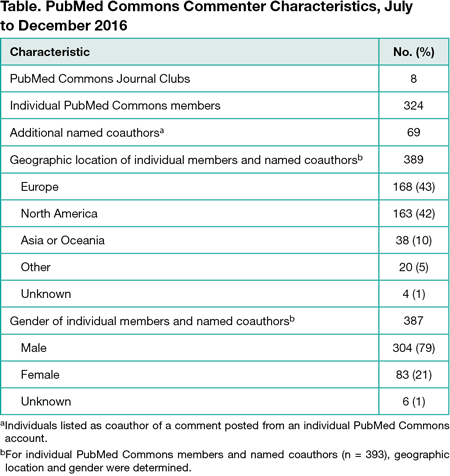Abstract
A Cross-sectional Study of Commenters and Commenting in PubMed, 2014 to 2016: Who’s Who in PubMed Commons
Melissa D. Vaught,1 Diana C. Jordan,1 Hilda Bastian1
Objective
Authors indexed in PubMed are eligible to join PubMed Commons and post English-language comments that appear directly below abstracts in PubMed. Journal club membership was introduced in 2014. We sought to describe characteristics of commenters and the extent of collaborative and author comments and replies.
Design
Basic usage data were collected for comments posted from January 2014 to December 2016 (online February 2017). We evaluated a 6-month subset for collaborative and author posts, as well as for commenters’ gender, country, and conflict of interest disclosure.
Results
At the close of 2016, 10,736 individuals and 24 journal clubs had joined PubMed Commons. From 2014 to 2016, 5483 comments were posted to 4372 publications, with 13% of individuals (n=1410) and 71% of journal clubs (n=17) commenting. The mean (range) number of comments per active individual was 4 (1-196), with 38% (n=537) posting more than 1 comment. For active journal clubs, the mean (range) was 8 (1-27), with 82% (n=14) posting multiple comments. From July 2016 to December 2016, 953 comments (17% of the 3-year total) were posted to 776 publications (18% of the 3-year total) by 332 members and a further 69 named coauthors (Table). Commenters were primarily from 5 English-speaking countries (n=244 [63%]) and 21% of all commenters were women. Authors posted 71 replies (8%) and 109 other comments (11%). Collaborative comments accounted for 21% of posts, including multiauthored and collective (eg, journal club) comments. Conflict of interest disclosures were formally or informally disclosed rarely (23 instances), often to declare an absence of conflicts of interest.
Conclusions
Most individual members of PubMed Commons have not commented, although a small number of members account for a considerable proportion of comments. Comments rarely include conflict of interest disclosures. Geographic distribution of commenters is not representative of authors in the biomedical literature, and women are underrepresented. Author replies are uncommon. Many comments are collaborative posts.
1PubMed Commons, National Center for Biotechnology Information (NCBI), US National Library of Medicine (NLM), National Institutes of Health (NIH), Bethesda, MD,USA, melissa.vaught@nih.gov
Conflict of Interest Disclosures:
All authors worked at NCBI when this study was being conducted, including when data were collected from PubMed Commons.
Funding/Support:
This work was supported by the Intramural Research Program of the NIH, NLM.
Role of the Funder/Sponsor:
The funder had no role in the design and conduct of the study; collection, management, analysis, and interpretation of the data; preparation, review, or approval of the abstract.

